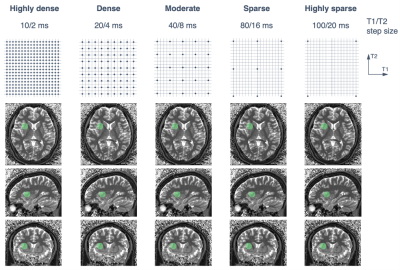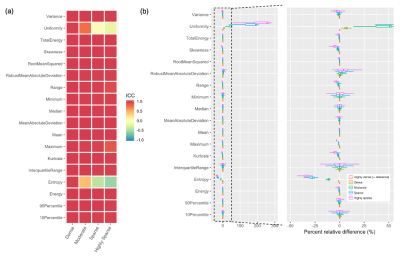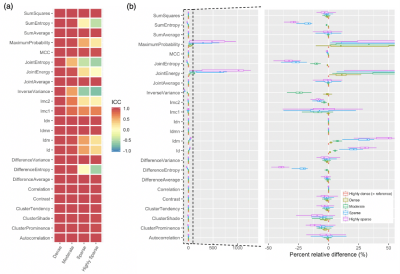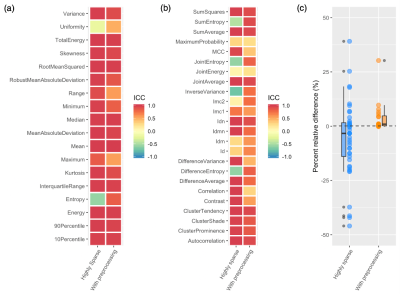3070
Radiomics with 3D MR fingerprinting: Influence of dictionary design on radiomic features and a potential mitigation strategy1Department of Radiology, Juntendo University, Tokyo, Japan, 2Department of Radiology, The University of Tokyo, Tokyo, Japan, 3Department of Radiology, The Institute of Medical Science, The University of Tokyo, Tokyo, Japan, 4Department of Radiological Sciences, International University of Health and Welfare, Narita, Japan
Synopsis
Understanding the dependencies of radiomic features on the dictionary step size in MR fingerprinting is crucial in the clinical implementation of MR fingerprinting-based radiomics. We investigated the influence of dictionary design in the radiomic analysis of MR fingerprinting and observed that radiomic features vary significantly for different designs. Moreover, special attention is required when using datasets containing maps generated from different dictionaries. We also demonstrated that an inverse quantization process can mitigate the influence of dictionary design on the radiomic features obtained with MR fingerprinting.
Introduction
Magnetic resonance fingerprinting (MRF) could be a key technology for reproducible radiomic analyses, as it generates highly reproducible quantitative maps.1-3 Pattern-matching in MRF is a distinctive feature in terms of reproducibility, since the reconstructed maps are dependent on the dictionary design. The influence of dictionary design on radiomic features should be considered when using datasets containing maps generated from different dictionaries. However, to the best of our knowledge, this has not been investigated previously. In this study, we investigated the influence of the dictionary step size on MRF radiomic features and evaluated the stability of each feature with different dictionaries. In addition, we introduced an inverse quantization process that could mitigate the influence of dictionary differences on radiomic features.Methods
MR fingerprinting acquisition and dictionary matchingAn overview of the process is illustrated in Figure 1A. Ten volunteers were scanned with 3D MRF using a 3-T GE 750w scanner, and written consent was obtained prior to the scans. The 3D MRF sequence was based on steady-state free precession with spiral projection k-space trajectory.4,5 The acquisition parameters of MRF were as follows: field-of-view, 200×200×200 mm; matrix size, 200×200×200; and acquisition time, 9 min 51 sec. The dictionaries were generated using the extended phase graph formalism, with T1 and T2 values ranging from 10 ms to 3000 ms and 20 ms to 1000 ms, respectively. The step size for each dictionary was defined as shown in Figure 2. Quantitative maps were obtained using a maximum inner product search,1 and we considered only MRF T1 maps for simplicity.
Data postprocessing
A spherical volume of interest (VOI) of diameter 20 mm was placed randomly inside the skull (Figure 2), and 500 VOIs (10 subjects, 50 VOIs per subject) were used in the analysis. PyRadiomics (version 3.0)6 was used to extract first- and second-order features from the VOIs for each dataset. For simplicity, we limited our analysis of second-order features to those derived from gray level co-occurrence matrices (GLCM)7, the most commonly used second-order feature in related literature. We used a default bin width of 25, and no image resampling, image intensity normalization, or image filter was used.
Statistical analysis
The interclass correlation coefficient (ICC) was calculated for each feature as a measure of the agreement between dictionaries, to evaluate the stability of the features against differences in the dictionary step size. We used a two-way random-effects model of the ICC (unit: single, type: agreement). To evaluate the effects of different step sizes on the radiomic features, the percent relative change was calculated with respect to corresponding references. The radiomic features obtained from the densest dictionary were used as references, assuming that it contains the highest amount of information.
Adjusting quantitative values obtained with a sparse dictionary
Using a highly sparse dictionary results in a low quantitative resolution. For example, the sparsest dictionary in our study has only 30 steps for the T1 values in the range of 100 ms to 3000 ms. We hypothesized that increasing the quantization steps of the quantitative maps derived from a highly sparse dictionary would improve the agreement between the features obtained with a highly sparse and dense dictionary. Patel et al. reported that a simple 3×3 spatial averaging filter can increase the dynamic range of images.8 However, this approach is not optimal, as it treats the center and neighboring voxels equally. Hence, we applied an inverse quantization process8,9 using a Gaussian function,10 assuming that the voxel initially at the center has the most influence on the voxel value (overview shown in Figure 1B). A spatial deviation of 0.4 mm was chosen empirically.
Results
Effect of dictionary step size on texture featuresAmong the first-order features, uniformity and entropy were vulnerable to the dictionary step size (defined as ICC<0.80) (Figure 3). Other first-order features exhibited reproducible results for different dictionaries. In general, first-order features were more reproducible than GLCM features (Figure 4).
Adjusting quantitative values obtained with a sparse dictionary
The features calculated after the inverse quantization process exhibited a lower percent relative difference than those calculated before (Figure 5). Although some ICCs decreased after inverse quantization, the mean value improved from 0.55 ± 0.61 to 0.71 ± 0.23 after inverse quantization.
Discussion
Our results show that even when the same source data are used, different MRF dictionaries can yield different radiomic features. Therefore, images obtained with different dictionaries may affect radiomics analysis when used simultaneously. We introduced an inverse quantization process using a Gaussian function that mitigates the influence of using different dictionaries on the radiomic features. This indicates that by using an appropriate quantization process, images obtained with different dictionaries could possibly be utilized simultaneously in radiomic analysis.Identifying conditions for which the differences between dictionaries are sufficiently smaller than clinically required precisions is a topic for future research. This may enable accurate radiomic analysis of MRF data from different dictionaries simultaneously.
Conclusion
Although visually indistinguishable, the radiomic features calculated from different maps may differ significantly. Therefore, special attention should be paid to maps obtained from different dictionaries during radiomic analyses.Acknowledgements
No acknowledgement found.References
1. Ma D, Gulani V, Seiberlich N, et al. Magnetic resonance fingerprinting. Nature. 2013;495(7440):187-192.
2. Korzdorfer G, Kirsch R, Liu K, et al. Reproducibility and Repeatability of MR Fingerprinting Relaxometry in the Human Brain. Radiology 2019;292(2):429-437.
3. Badve C, Yu A, Dastmalchian S, et al. MR Fingerprinting of Adult Brain Tumors: Initial Experience. AJNR Am J Neuroradiol. 2017;38(3):492-499.
4. Cao X, Ye H, Liao C, Li Q, He H, Zhong J. Fast 3D brain MR fingerprinting based on multi-axis spiral projection trajectory. Magn Reson Med 2019;82(1):289-301.
5. Buonincontri G, Kurzawski JW, Kaggie JD, et al. Three dimensional MRF obtains highly repeatable and reproducible multi-parametric estimations in the healthy human brain at 1.5T and 3T [published online ahead of print, 2020 Nov 19]. Neuroimage. 2020;226:117573.
6. van Griethuysen JJM, Fedorov A, Parmar C, et al. Computational Radiomics System to Decode the Radiographic Phenotype. Cancer Res. 2017;77(21):e104-e107.
7. https://pyradiomics.readthedocs.io/en/latest/features.html
8. Patel MB, Rodriguez JJ, Gmitro AF. Effect of gray-level re-quantization on co-occurrence based texture analysis. In 2008 IEEE International Conference on Image Processing, ICIP 2008 Proceedings:585-588.
9. Numada M, Fujiwara T, Watanabe Y, et al. An inverse quantization method using sinc function for image. Journal of the Japan Society for Precision Engineering 2010;76(9):1054-1058.
10. Haddad RA and Akansu AN. A class of fast Gaussian binomial filters for speech and image processing. In IEEE Transactions on Signal Processing 1991;39(3):723-727.
Figures




